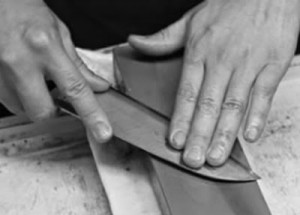How to Sharpen a Knife Rightly
16th Jul 2024
1. How to Sharpen Double-edged Knives
In most cases, kitchen knives can successfully be re-sharpened. Do you like to try that for razor-sharpness ? We recommend to sharpen your knife with waterstones for better sharpening, not with a grinding rod.
Does that look to really expend much time and effort compared to the benefit?
Don’t worry about it. It get easy to for you use the stone soon.
Double-Edged Knives are generally called "Ryo-ba" in Japanese. "Ryo" is the both side, and "ba" is the edge of blade. Western style knives are mostly "ryo-ba" for right and left-handed persons.
In Japan, a lot of types of Western style knives are manufactured from Meiji-era, 19th century. The representative Japanese ryo-ba blade is made of hagane in the core sandwiched by soft steel layers from the both side.
Its quality is now said the best, and have got more and more popular riding a wave of Japanese food spreading in the world.
Of course, please be noted that it is sometimes impossible if the issued knife has a large chip and damage or if the blade was seriously bent.
2. How to Sharpen Single-edged Knives
“Single-Edged” blade is the basic form in the traditional Japanese kitchen knives for a long time, that is completely different from that of the traditional Western knives. But, some don’t know how to rightly sharpen a “Single-Edged” knife where the edge has unfortunately gotten chipped, bent and rusted. If you learn how to sharpen, your knives are sure to get extremely sharp again.
Let’s watch the following video that teaches you plainly the right method of “Single-Edged” knife sharpening.
3. What angle I should sharpen the knife at?
Some customers have asked so far, “Just wondering what angle I should sharpen the knives I bought at?”
The sharpening angle depends on the intended use,of course. Generally speaking, approx. 10 degrees between the surface of the blade and whetstone would be recommended if you cut only soft things.
12~15 degrees would be recommended if you cut some hard materials.
**This is just for double-edged blades.
Please refer to the attached picture.

The following Sharpening guide will help you effectively and easily. Please try it.
4. Sharpening Guide Tool
For better sharpening you knives, we recommend you to use a Sharpening Guide. The guide is designed to help maintain the correct angle for sharpening knives when sharpening with a whetstone.
Any time you remove the guide rail from your knife, rinse and clean it thoroughly to remove any residue from the stone that may remain inside the guide rail.

The guide slides onto the spine of the knife to keep your angle constant when sharpening on a stone as shown in the following video (example),
To further insure that no residue remains, it is recommended that you pull a clean towel through the guide rail after rinsing.
If you fail to remove the entire residue from the guide rail, the residue may scratch the knife the next time the guide rail is used.
Works great and has a white slip strip to make for easy use and prevents you from scratching or gouging your stones.
We recommend you put some painter’s tape on your knife to avoid minor scratches when slipping the sharpening guide on and off your knife.
5. Whether is the knife ready to use straight away?
Recently, a customer asked us, “whether is the knife ready to use straight away or needed to be sharpened by myself?” Normally, a obtuse angle finishing at the blade edge by a machine in manufacturers (called “standard blade finishing (sharpening)”) is applied to most of the knives that are stocked and displayed in the store.
It is thought enough for general use, because manufacturers apply the standard finishing for various possible application. (Regarding some high-end knives, the edge of the blade has to be hand-finished one by one before shipment. That is stated in the description in the item page.)
 (machine finishing)
(machine finishing)
 (hand finishing)
(hand finishing)
Professional chefs often apply a hand-finishing (fine-grinding by hand) to the blades by themselves just after they buy the knives. If the chefs would like to cut just soft ingredients, acute (sharper) angle at the edge would be great to stimulate its cutting performance.
On the other hand, if they have to cut hard ingredients, obtuse angle at the edge must be good to prevent the edge from easy chips.
Some professionals make their knives easier to use through such a self-finishing customization as semi-single edged, semi-double edged (like 70:30) or as special edged with different edge angles from the point to point.
If you have any question, please feel free to contact us anytime.
Thank you for reading and best regards!
All the Hocho-Knife staff
~~~~~~~~~~~~~~~~~~~~~~~~~~~~~~~~~~~~~~~~~~~~~~~~~~~~~~~~~~~~~~~~~~
“Hocho” represents Made-in-Japan (Sushi / Sashimi) Kitchen Knives,
that is the soul of the cook!
~~~~~~~~~~~~~~~~~~~~~~~~~~~~~~~~~~~~~~~~~~~~~~~~~~~~~~~~~~~~~~~~~~


